Related Research Articles

The penny-farthing, also known as a high wheel, high wheeler or ordinary, is an early type of bicycle. It was popular in the 1870s and 1880s, with its large front wheel providing high speeds, owing to it travelling a large distance for every rotation of the legs, and comfort, because the large wheel provided greater shock absorption.
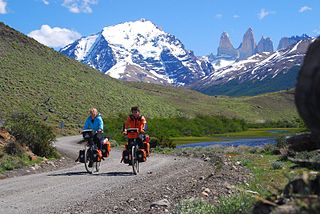
Bicycle touring is the taking of self-contained cycling trips for pleasure, adventure or autonomy rather than sport, commuting or exercise. Bicycle touring can range from single-day trips to extended travels spanning weeks or months. Tours may be planned by the participant or organized by a tourism business, local club or organization, or a charity as a fund-raising venture.

The League of American Bicyclists (LAB), officially the League of American Wheelmen, is a membership organization that promotes cycling for fun, fitness and transportation through advocacy and education. A Section 501(c)(3) nonprofit organization, the League is one of the largest membership organizations of cyclists in the United States.
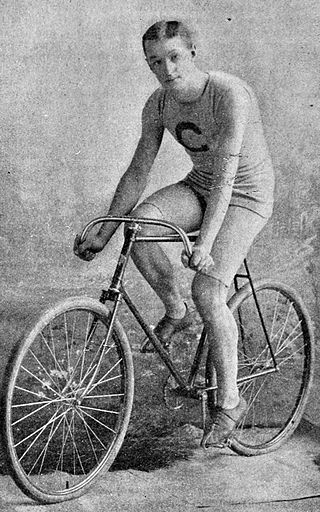
John Sigfried Johnson was an early American cyclist and speed skater. He was born as Johan Sigfrid Jonsson in Sweden and emigrated with his parents to Minnesota in the United States in 1881.

John Forester was an English-American industrial engineer, specializing in bicycle transportation engineering. A cycling activist, he was known as "the father of vehicular cycling", for creating the Effective Cycling program of bicycle training along with its associated book of the same title, and for coining the phrase "the vehicular cycling principle" – "Cyclists fare best when they act and are treated as drivers of vehicles". His published works also included Bicycle Transportation: A Handbook for Cycling Transportation Engineers.

Horatio Sawyer Earle (1855–1935), known as the "Father of Good Roads" or simply Horatio "Good Roads" Earle, was an American transport engineer.

Since the advent of the bicycle in the 1860s, Chicago has been distinguished as one of the premier cycling locations in the United States, with such public cycling destinations as Grant Park, Burnham Park and the Chicago Park District's Lakefront Trail.

Joe Breeze is an American bicycle framebuilder, designer and advocate from Marin County, California. An early participant in the sport of mountain biking, Breeze, along with other pioneers including Gary Fisher, Charlie Kelly, and Tom Ritchey, is known for his central role in developing the mountain bike. Breeze is credited with designing and building the first all-new mountain bikes, which riders colloquially called Breezers. He built the prototype, known as Breezer #1, in 1977 and completed nine more Series I Breezers by early 1978. Breezer #1 is now in the collection of the Smithsonian Institution’s National Museum of American History.

Dan Henry (1913-2012) is the inventor of directional pavement markings commonly used to guide participants along the route of organized bicycling events. The markers themselves are usually called Dan Henry Arrows.

A bicycle boulevard, sometimes referred to as a neighborhood greenway, neighborway, neighborhood bikeway or neighborhood byway is a type of bikeway composed of a low-speed street which has been "optimized" for bicycle traffic. Bicycle boulevards discourage cut-through motor-vehicle traffic but allow local motor-vehicle traffic. They are designed to give priority to bicyclists as through-going traffic. They are intended as a low-cost, politically popular way to create a connected network of streets with good bicyclist comfort and/or safety.

Connie Carpenter-Phinney is an American retired racing cyclist and speed skater who won four medals in World Cycling Championship competitions in the late 1970s and early 1980s. She also won the gold medal in the cycling road race at the 1984 Summer Olympics in Los Angeles, as well as twelve U.S. national championships. She remains the youngest American woman to compete at the Winter Olympics.

Keith Kingbay was a racer, manufacturer, advocate, and author in bicycling. He was raised in Kenosha, Wisconsin, USA, and became a road and track racing cyclist in the 1940s before moving to Chicago to work for the Schwinn Bicycle Company.
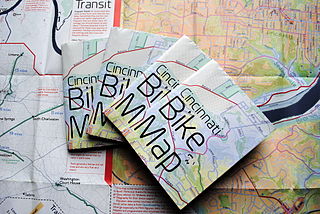
A bicycle map or bike map is a road map designed specifically for bicyclists. Bike maps often include features not on general purpose street maps such as bike lanes, bike paths, bike routes, bike shops, topographical features like major hills, etc. Earlier in the 20th century, bike maps tended to focus on showing pavement quality.

The Massachusetts Bicycle Club (est.1879) was a cycling club in Boston, Massachusetts.
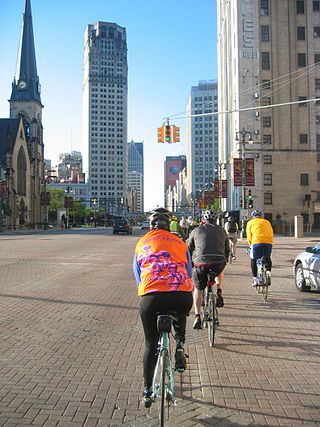
Detroit is a popular city for cycling. It is flat with an extensive road network with a number of recreational and competitive opportunities and is, according to cycling advocate David Byrne, one of the top eight biking cities in the world. The city has invested in greenways and bike lanes and other bicycle-friendly infrastructure. Bike rental is available from the riverfront and tours of the city's architecture can be booked.

Bicycle use in Portland, Oregon has been growing rapidly, having nearly tripled since 2001; for example, bicycle traffic on four of the Willamette River bridges has increased from 2,855 before 1992 to over 16,000 in 2008, partly due to improved facilities. The Portland Bureau of Transportation says 6% of commuters bike to work in Portland, the highest proportion of any major U.S. city and about 10 times the national average.

Tillie Anderson was a road and track cyclist. Tillie, a Swedish immigrant and, from all accounts, an extremely strong-willed individual, outpaced the best of the best on the wheel, with times that are still impressive today. Born in Skåne, Sweden in 1875, Tillie emigrated to Chicago in 1891 at the age of 16. At 18, she had saved enough money working as a seamstress to buy her first bicycle. During the summer of 1895, she took part in the race over the Elgin-Aurora (Ill.) century course and broke the century record. She later traveled around the country taking part in six-day bicycle races for women, which involved racing at top speed two hours each evening for six consecutive days. Tillie was 20 years old when the League of American Wheelmen recognized her as the best woman cyclist in the world. In June 2000 – 105 years later - Tillie was posthumously inducted into the United States Bicycling Hall of Fame, an undisputed champion and a true pioneer in women's athletics.
Wheelman, wheel-men, or variation, may refer to:

John Vande Velde is an American track cyclist who competed on velodromes around the world, winning three national championships, and he competed at the 1968 Summer Olympics and the 1972 Summer Olympics. He was a 2004 inductee into the U.S. Bicycling Hall of Fame.
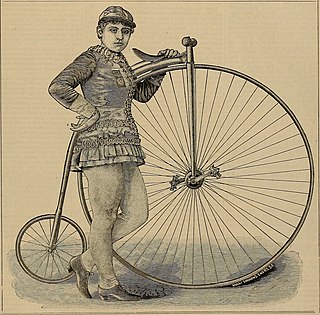
Louise Armaindo, born either Louise or Louisa Brisebois or Brisbois (1861–1900), was a Canadian strongwoman, trapeze artist, competitive walker, and high-wheel cyclist. Throughout the last decades of the 19th century, she was known as "the champion female bicycle rider of the world."
References
- 1 2 3 Greenfield, John (2014-07-29). Modeshift Volume 4, Issue 2. Active Transportation Alliance. "Phyllis Harmon: "The grande dame of biking". activetrans.org/modeshift/04_02/grande-dame-of-american-cycling. Retrieved 2014-07-29. Archived 2015-03-17 at the Wayback Machine
- ↑ The Chain Link website
- ↑ Sturges, Barbara. "Mission and History". League of American Bicyclists. bikeleague.org/content/mission-and-history. Retrieved 2014-07-29. Archived 2013-06-27 at the Wayback Machine
- 1 2 3 4 McCormick, Patrick, J. (2003). "Phyllis W. Harmon: League MVP". wheelmen.com/phyllis_article.htm. Retrieved 2014-07-29. Archived 2013-03-28 at the Wayback Machine
- ↑ Wheelmen official website
- ↑ Stanley, Kameel (2011-05-07). Tampa Bay Times. "Lifelong cyclist, 94, finds her wheels with daughter's help". tampabay.com/news/humaninterest/lifelong-cyclist-94-finds-her-wheels-with-daughters-help/1168455. Retrieved 2014-07-29. Archived 2011-05-11 at the Wayback Machine
- ↑ Staff (2016-08-31). "Phyllis W. Harmon Obituary". Tampa Bay Times . Retrieved 2016-08-31.
- ↑ Clarke, Andy. Phyllis Harmon. "Change Agents for Cycling". American Bicyclist. Fall 2005: p.14. wheelmen.com/Change_Agents.pdf. Retrieved 2014-07-29. Archived 2014-09-10 at the Wayback Machine
- ↑ Wheeling Wheelmen. "US Bicycling Hall of Fame". wheelmen.com/USBHF.htm. Retrieved 2014-07-29. Archived 2006-03-19 at the Wayback Machine
- ↑ Wheelmen official website
- ↑ Chicago Magazine website
- ↑ U.S. Bicycling Hall of Fame website
- ↑ The Chain Link website